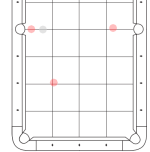Let me save you another 8 years of toiling:
There is no universal solution on how to run racks. Different players will have different specialities when it comes to shots. Some may prefer outside english, some play mostly plain ball, some play all shots. General principles, which are time tested, are as follows:
1. Shots should, whenever possible be shot in a way to minimize the risk of skids, but at the same time not so hard as to make pocketing more difficult.
2. Movement of the cueball should be minimized.
3. Movement of the cueball should take place in a manner which decreases risk of accidental contact with other balls, and scratching.
4. Reach should be considered for all positions.
5. In general, key balls should be positioned near a pocket or near a rail, but usually not frozen to a rail. Key balls in the middle of the table should be avoided, unless you have a key ball to the key ball which is close to a rail or pocket and leads directly to the key ball in the middle of the table.
6. The cueball should be kept near center table for most shots, in order to maximize opportunities.
7. The cueball should be kept above the rack for most shots, in order to maximize opportunities and to enlarge the position zones.
8. The cue balll should be kept away from the rail at all times.
For breakshots, I think the Mosconi style has been the one method that seems more condusive to high runs. High angle, high ball into center or slightly above center pack. Object ball close, but not too close to the pack, so as to enlarge the pocket.
Here is the programming problem.
All reds can be made, which red should be first?
The classification problem begins:
A break ball and pocket have to be assigned early on.
Assign the red "arbitrarily." The corner pocket and the red nearest it, to define the break conditions and ideal position for cueball.
That invokes a condition the cueball must be on the left side of the break ball in the grid and above it, with an angle.
The only shot that has contact with the cue ball in the break section is the left side pocket shot.
Right pocket side shot has to be made, minimum power, draw or stun.
What happens when the computer has multiple shots that can leave the cue ball in that region. I would need a return theorem for traversing the table using available shots.
I appreciate you explaining the general strategy. The problem I am dealing with is for logic of individual cases.
If you added another red to the table, where would you place it to confuse the above logic?
